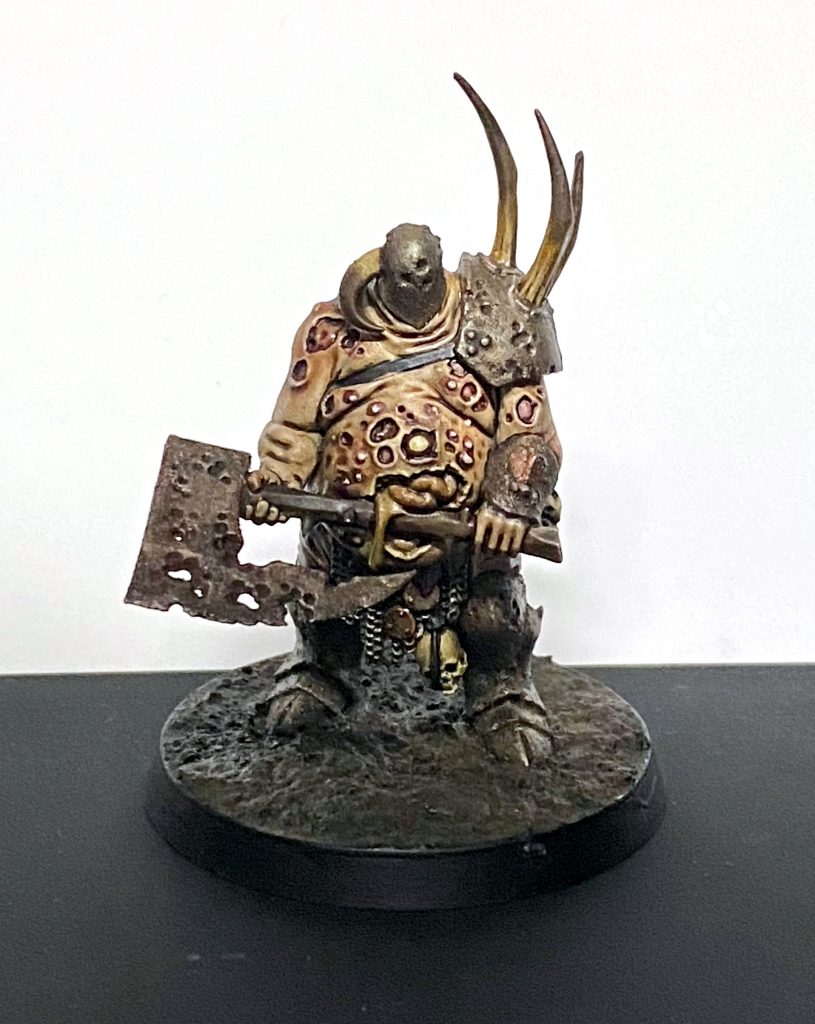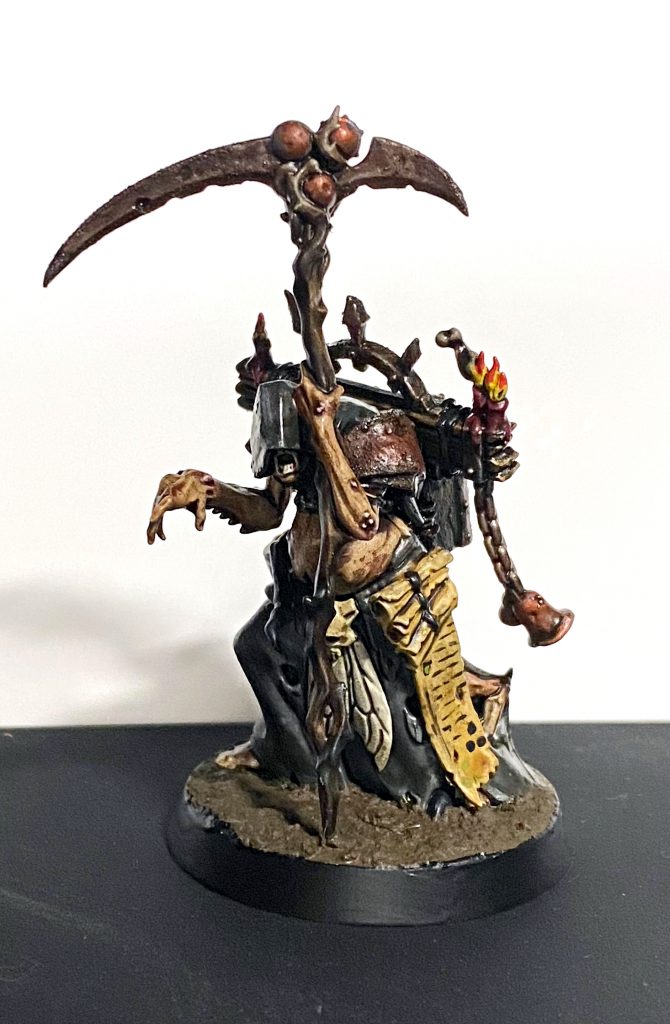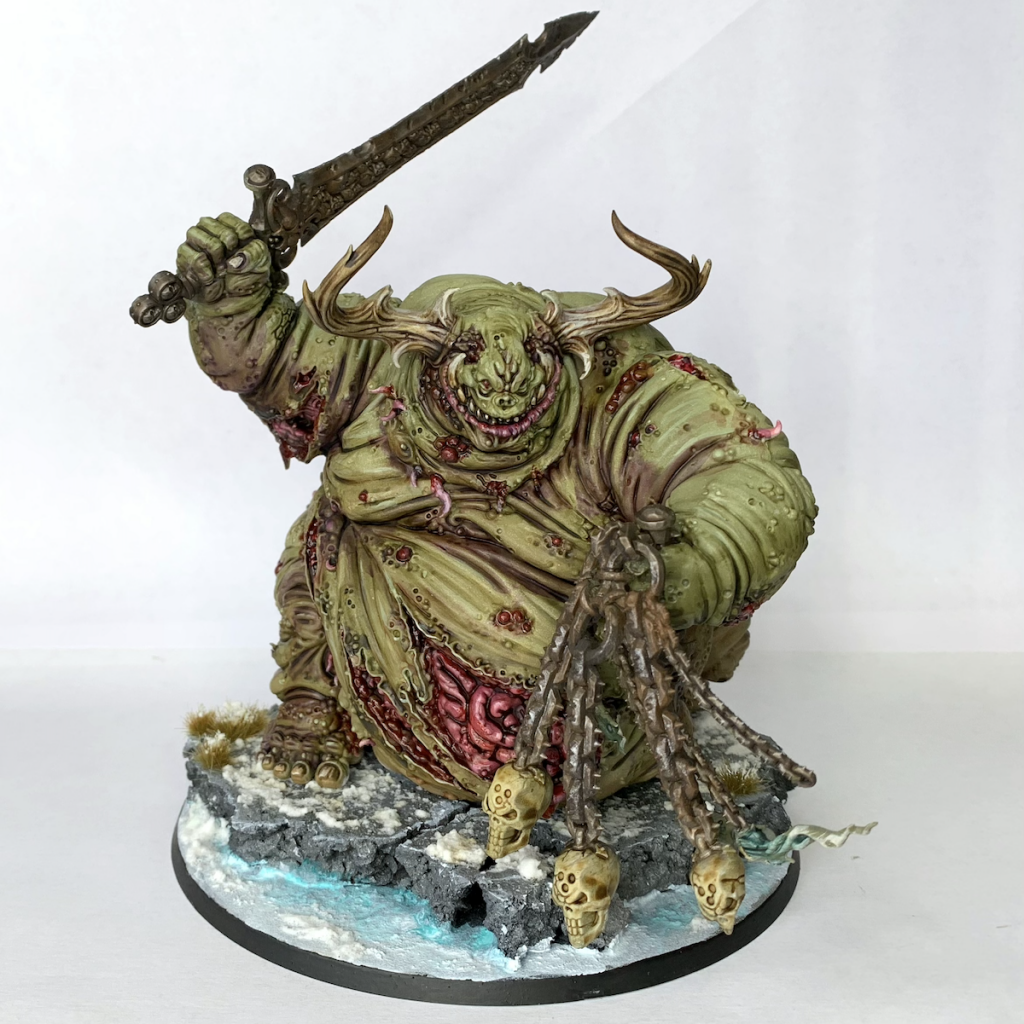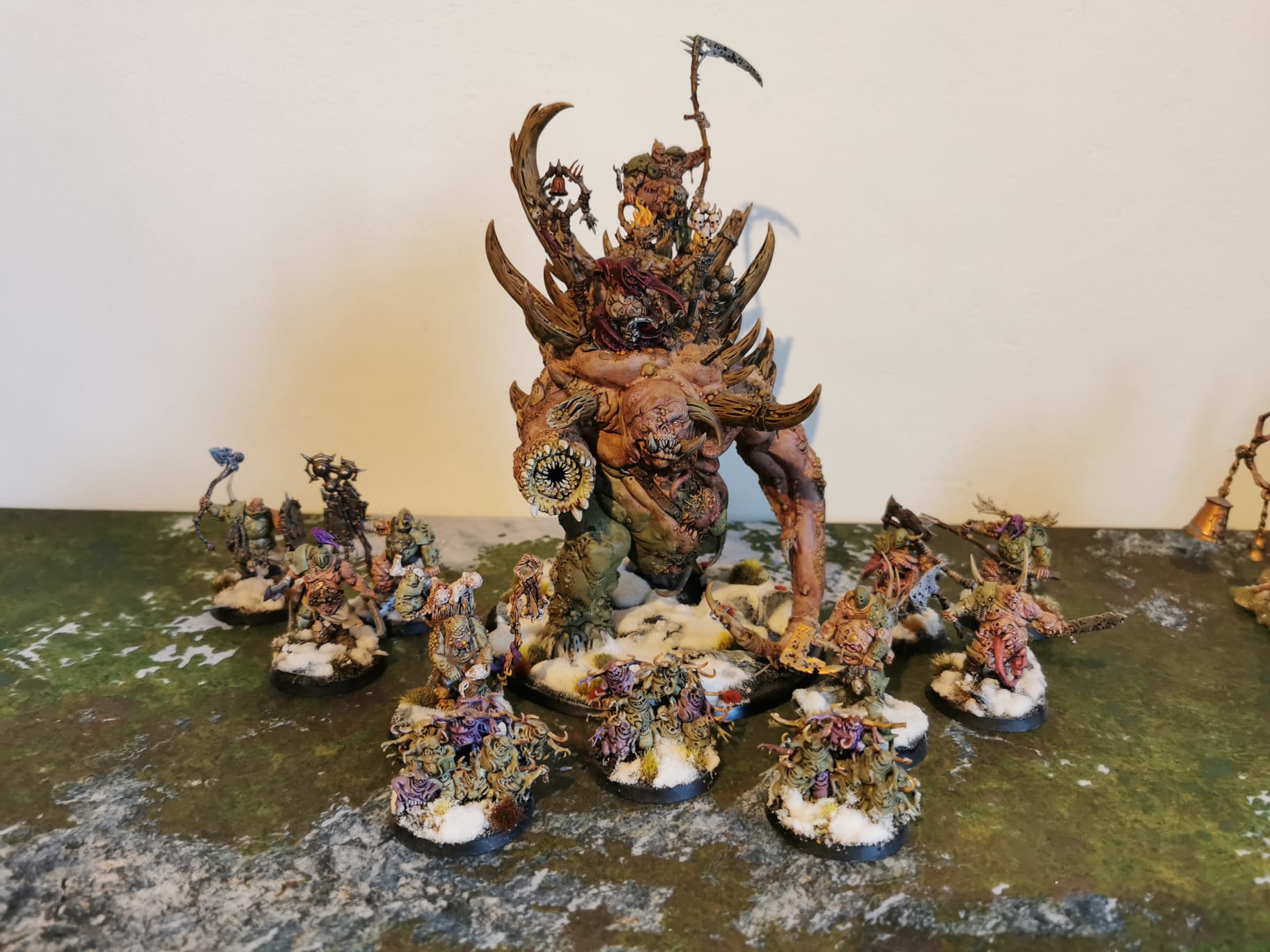Previously we looked at the new Maggotkin of Nurgle Battletome from a more competitive or matched play perspective. Today we look at the Path to Glory rules and how they work in your narrative campaigns.
Your Narrative
Path to Glory is all about setting up your own army’s narrative in a larger campaign with your friends and local group of players. The rules for the Maggotkin book open up new options for your army, the territories you can control and even the role you play in some of the narrative missions with unique Quests and Veteran Abilities as well.
There’s also a name generator if you’re as bad as I am when it comes to thinking of names for your models with some rather hilarious combinations possible (thanks Papa Nurgle) like Liverlash the Lord of Entrails. Not just a name generator for your heroes though there’s also a table of names for mutations and diseases for your army to spread! These don’t offer any further rules, it’s all just to help you set up a more in depth backstory for your force.
An interesting twist is that Daemon units that are not Heroes are not recorded on your roster at all. A concept first introduced with the Seraphon Tome Celestial, when setting up your army for battle you instead can choose 3 daemon units per Great Unclean One or the Glottkin and 1 per Nurgle Daemon Hero. So if you have 1 Great Unclean One, a Sloppity Bilepiper and a Poxbringer you can choose up to 5 Daemon units for your army for that battle. This represents that most lesser daemons are amorphous and tend to fade back into the Realm of Chaos once their short-lived existence has ended.

The Quests
As is very fitting for Nurgle you get 3 unique quests to try and achieve for your force in games. Each are fairly simple to achieve but completing them gives you different bonuses.
- Spread Corruption – You get 1 quest point towards completing this quest if you win a major victory in your game. Very simple. After 3 quest points (3 major victories) you get to seed one of the territories you control (more on that below). You want your territories to be seeded so this is a good one to just go for often.
- Gardener of Nurgle – Similar to the one above you get 1 quest point for each minor victory but 3 for each major victory making it a little quicker to complete. After you have 3 quest points then you can use to the Seeds of Corruption battleplan and gives you rewards if you win a minor or major victory during that game.
- Feculent Devotions – At the end of a Path to Glory battle you’re awarded 1 quest point for each Feculent Gnarlmaw added during the battle (not including ones that were set up before the game began). After you have at least 3 Quest points then in your next game you can give each of your Plaguebearer Host and Plague Drones units a Veteran ability for that battle only. This one is a little funny in that it doesn’t have any long term effects and Veteran Abilities are rather limited too, being only once per turn in your army.
The Garden of Nurgle
Like other new tomes, you have a few new territories to play around with. If you roll a 61-66 on an exploration roll then you get access to unique Nurgle territory, which corresponds to one of the stock options but has more powerful effects. If you don’t care what you get, you can choose a base option, choosing a roll of 21-42 instead. The unique ones are:
- Crawling Swamp (Wild Lands) – Increase your Monster limit by 2 and during step 7 of the aftermath sequence you can roll a dice, if you get a 6 then you get to add 1 Beast of Nurgle unit to your roster or reinforce 1 Beast of Nurgle unit instead. There are very few Monsters in your army to begin with unless you’re using allies and coalition units to get Beasts of Chaos or Slaves to Darkness monsters on your roster. This is also noted as being strictly different from the normal rules of not recording such units on your roster, meaning it won’t take up one of the slots allowed in games if you’re going solo or mainly Daemon heavy.
- Meadows of Arcane Corruptions (Arcane Waypoint) – Increase your Wizard limit by 2 and during step 7 of aftermath roll a dice, on a 6 you can add 1 Nurgle Mortal Wizard unit to your roster without spending any glory points. A nice way to add wizards to your army, especially Rotbringer Sorcerers.
- Befould City (Small Settlement) – Increases your reinforcement limit by 2 and during step 7 of aftermath on a dice roll of 6 can reinforce 1 Nurgle unit without spending any Glory. Reinforcing your mortal units will actually be fairly rare because of how expensive they are to begin with so unless you’re going Pusgoyle heavy it won’t be too necessary to aim for this early.
- Fortress of Corroded Iron and Blubber (Borderlands) – Probably the longest named one I’ve seen yet? In step 3 of the aftermath you roll 3 dice and for each 5+ you can give 1 unit on your roster that was not in the battle 1 renown point or add 1 quest point to the progress of your quest if it’s Feculent Devotions.
- Feculent Forest (Wellspring) – During every aftermath you pick D3 different units to benefit from the territory. When making recuperating rolls for a unit (not hero) that was chosen it’s treated as not taking part in the battle at all meaning you’ll be rolling 2+’s instead of looking for 4+ rolls. Instead of picking any units though you can add 1 quest point to your Gardener of Nurgle quest if you have it active.
- Filth Pit (Realmstone Reserve) – You simply receive 3 extra glory during the aftermath sequence or instead can add 1 point to the progress of Spread Corruption Quest. This is really good, very simple, and will always benefit you!

Seeding the Garden
In addition to discovering new territories as normal you can also seed your territories by completing the Gardener of Nurgle or Spread Contagion quest. If you play the Encroaching Corruption battleplan then you may be able to seed a territory as well!
Seeding a territory is easy, if you are given the opportunity to then at the end of step 6 of aftermath then choose a territory you control and replace it with the Nurgle version (listed above).
On the opposite end of that if your opponent is given the opportunity to revert a territory after it’s been corrupted then instead of you making an exploration roll in step 6 your opponent picks one of your territories and reverts it to its original form. You still keep the territory but it’s no longer all slimy and gross.
Blighted Landscape
If you’re using the Path to Glory battleplans from the core book and you are designated the role of Defender then you must use the Blighted Landscape rules. You’re the defender if the battleplan lists you as ambusher, custodian, guarding, or ritualist. Playing on a Blighted Landscape adds additional rules to the game as follows:
Hidden Corruption – In your own hero phase choose D3 different units within 3” of any terrain features and on a 4+ that unit is given 1 Disease Point if it’s an enemy unit, or if it’s friendly then you receive 1 Contagion Point instead. Being able to punish enemy units that are hiding in terrain or being able to bring more daemons to the table a little quicker is a pretty big boon either way, since it’s for free.
Aid Me, Grandfather! – Once per battle when a Nurgle Hero is slain (mortal or daemon) before removing it from the table you beseech Nurgle for help by rolling 1 dice. On a 6 the hero is not slain and instead all of its wounds are healed and any other further wounds yet to be allocated from the same attack are negated. On a 3-5 the hero is slain as normal. On a 1 or a 2 though the hero is still slain but before you remove it you add 1 Beast of Nurlge unit to the field.
Tearing Down the Garden – If your opponent wins the battle then they roll a dice and add 2 to the roll if they won a Major Victory. On a 6+ they can revert one of your corrupted territories.

Veteran Abilities
Whenever one of your units gains access to a Veteran Ability then instead of choosing one of the ones from the Core book you can use one of the following instead. These are still limited to being used once per game by that unit and only one Veteran Ability can be used each turn as well across your army as per usual.
- Driven by Devotion – Used at the start of a combat phase, you receive 1 Contagion Point for each enemy model slain by an attack made by this unit that phase. This ability can give you an insane amount of Contagion Points to be able to summon a nice chunky unit of Plague Drones or even a Great Unclean One in your next turn.
- Unnatural Regeneration – At the end of any phase where any models in this unit was slain, roll a dice for each model in the unit that was slain in that phase and each 4+ revives a model back to the unit. Able to bring back any number of Pusgoyle Blightlords or Blightkings to a unit is definitely nasty and is a much easier roll than the Rally order.
- Boon of Virulence – Activated at the start of a combat phase the unit inflicts 1 Disease Point for each hit roll of 5 or 6 instead of just 6. Nice little way to really stack up more Disease Points on enemy units.
- Revolting Resilience – Before making Disgustingly Resilient ward rolls for a unit you can use this to add 1 to those ward rolls until the end of the phase. Boosting any unit up to a 4+ ward save will keep them around longer, even if only for a turn.
- Blessed with Fecundity – At the start of any phase this this unit is counted as being in range of a Locus of Fecundity until the end of the phase. You’re needing to use this in the Hero phase to make use of it so I’m not sure why they say it can be used any phase…the Locus will heal the unit for D3 wounds instead of just 1, which when you roll it might just be 1 anyways. A little weak for a veteran ability unfortunately. In fact it’s the only one here that’s probably not going to be chosen much.
- Cycles within Cycles – Use this ability to move the Cycle of Corruption forward 1 stage after it moves during the start of your hero phase. All of the stages on the Cycle are pretty useful now actually but ways of being able to manipulate it are all but gone so getting to advance it a stage to get to one you really want active is pretty big.
Battleplans
The book gives us 2 new Path to Glory Battleplans to play in place of the Core Book ones.
Seeds of Corruption
If you have completed the Gardeners of Nurgle Quest then you can choose to use this Battleplan instead of one from the Core Rules.
Deployment is set up lengthwise with the opposing player having ¾ of the board as their territory and the Nurgle army set up along a short edge in the last ¼ section. The nurgle player is the Gardener and the opposing player is the Defender. The Defender can set up 1 faction terrain piece as normal but the gardener cannot set up any before the game starts. The armies start potentially close too with the Defender set up 9” away from enemy territory and the Nurgle player able to deploy anywhere in their own. One objective (cessnode) is placed dead centre of the table with 2 more cessnodes further back into Defender’s territory. The Gardener can change a cessnode into a rotnode by setting up a Feculent Gnarlmaw within 1” of the centre of it. The best way to do this will be with Horticulous Sliux or simply by summoning them in.
After 5 battle rounds if the 3 cessnodes have all been changed into rotnodes then the Nurgle player wins a major victory but if only 1 or none of them have been changed then the defender instead wins a major victory. If 2 cessnodes have been converted then the players add up the points values of destroyed units and whoever killed more wins a minor victory instead, if that’s an even tie then the battle is a draw.
If the gardener wins the battle then they complete the Gardener of Nurgle quest and can seed a territory. If the defender wins the gardener must instead reduce the number of quest points on the Gardener of Nurgle quest to 2.
On top of all of that, each of the gardener’s units that’s within 3” of a rotnode at the end of the battle is given 1 renown point. Similarly, each enemy unit within 3” of a cessnode at the end of the battle is given 1 renown point.

Encroaching Corruption
This battleplan doesn’t require a quest to be played and can simply be chosen if one player is using a Maggotkin of Nurgle army instead of one from the Core Book.
One player is the Corruptor and the other is the Defender. The Maggotkin player is always the Corrupter always and their list must include a Great Unclean One, Horticulous Slimux, The Glottkin, Festus the Leechlord or a Feculent Gnarlmaw.
The board is split into two equal halves with units being deployed more than 9” from the opposing territory and each player allowed up to 1 faction terrain piece.
The defender has access to a command ability for the duration of the battle called Burn Out the Rot! which is ordered to a unit within 3” of a Feculent Gnarlmaw and more than 3” from all enemy units. The ordered unit rolls a dice and on a 2+ the gnarlmaw is removed and the unit that removed it suffers D3 mortal wounds. This is important though as these plague trees can win the corruptor the game.
The corruptor has to have at least one Great Unclean One, Horticulous Slimux, The Glottkin, Festus the Leechlord or a Feculent Gnarlmaw within both their own and their opponents territories to claim a major victory. If any of these are only present in enemy territory then it’s a minor victory instead. The defender instead wins a minor victory if there are none of the listed units in their own territory and a major victory if there are none on the table at all.
If the corruptor wins then they can seed a territory and if the defender wins then they can revert a territory.
Also, any unit in enemy territory at the end of the game gains 1 extra renown point.
This seems like a fun mission to play but if the corruptor brings multiple of the units listed to gain victory can be a really tough fight for the defender, especially as the battle goes on and Gnarlmaws can be summoned to the table to add more issue but at least they can be removed easily through the command and through monstrous rampages.
Putting the Play in Plague
Path to Glory is a very different way to how a lot of people look at Age of Sigmar, which is usually through the Matched Play rules. It’s great to see that each battletome is getting its own set of unique and very fitting rules to incorporate and change how campaigns are played. The Maggotkin book definitely doesn’t disappoint when it comes to it’s unique rules and I’m looking forwards to starting a campaign next month with it!


